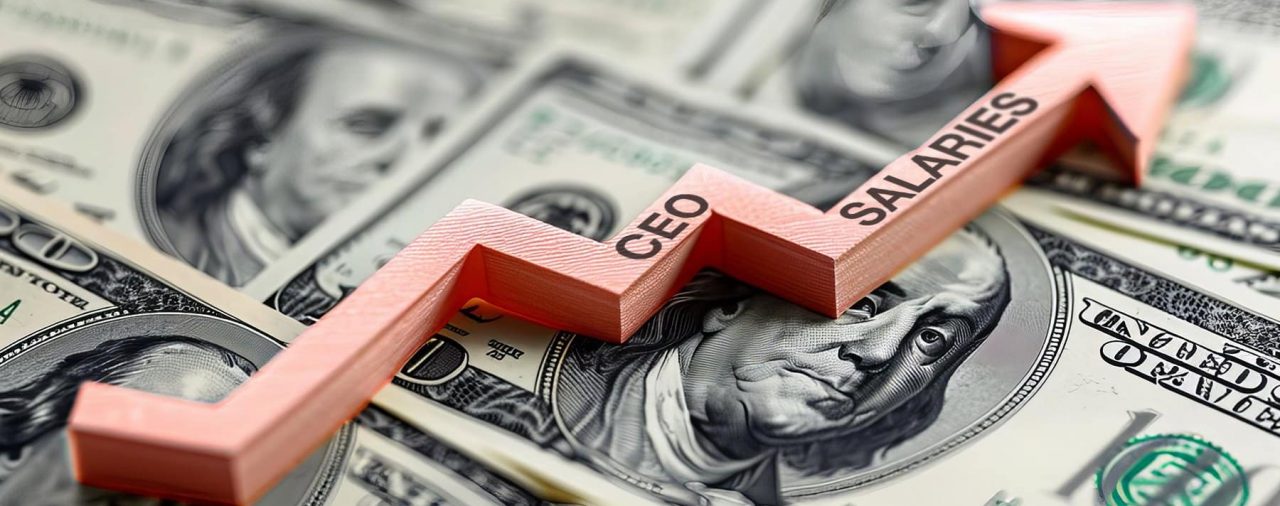Content Highlights
New data on CEOs salaries and compensation have revealed that in 2023, executive pay reached unprecedented levels. The latest data show that while CEOs continue to amass wealth, the gap between their earnings and those of average workers remains wide.
At Gardner Employment Law, we keep an eye on news and trends that relate to executive compensation. Read on to explore the key findings from the recent report on CEO salaries.
How High Did CEOs’ Compensation Levels Reach in 2023?
The annual review of executive compensation for 2023 highlights some staggering figures. The median CEO-to-worker pay ratio for 2023 was around 300 to 1. Traditional pay metrics have long showcased the significant earnings of top CEOs, but recent adjustments have further magnified these numbers, as explained by the New York Times. Now companies must disclose how much their CEOs’ stock holdings increase when the market rises. Key findings include:
-
- Top Earnings: Four CEOs received over $150 million each in traditional pay. Jon Winkelried of TPG led the pack with $198.7 million, which includes a combination of salary, bonus, stock awards, and other incentives.
- Elon Musk’s Windfall: Under new disclosure rules, Elon Musk’s 2023 compensation was $1.4 billion, reflecting the value of stock options that are tied to Tesla’s performance. However, this figure includes stock holdings that Musk may not legally claim, as it stems from a now-voided $46.5 billion pay package. More to come on Mr. Musk’s rank in top earnings.
- Broader Impact: The total disclosed compensation for the top 100 CEOs in 2023 reached unprecedented levels, according to experts who have analyzed the historic data. The median pay for CEOs in 2023 was over $29 million. This contrasts the medium annual wage for American workers, which was around $65,470 for the same time period.
- Stock Performance Influence: The increase in reported CEO pay was partly due to the rise in stock prices. As stock values climb, the potential value of stock options and holdings increases, contributing to larger reported compensation figures. This effect was pronounced in 2023, with many CEOs reaping substantial gains from their stock holdings.
The updated disclosure requirements, stemming from the Dodd-Frank Act, mandate companies to report how much the value of a CEO’s stock holdings increases with market rises. This statute has resulted in reporting the higher compensation figures, emphasizing the growing disconnect between executive pay and average worker wages. However, most of the average workers do not count increases in the stock holdings as compensation.
What Are the New Compensation Metrics to Measure CEOs’ Earnings?
The introduction of “compensation actually paid” (CAP) metrics offers a new perspective on CEO earnings, reflecting annual changes in the value of stock holdings. This method has revealed even more dramatic figures compared to traditional measures. Here are some important points:
-
- CAP Highlights:
- Elon Musk: Reported gains of $1.4 billion, although this is based on stock he no longer legally owns.
- Alexander Karp: The Palantir Technologies CEO saw nearly $1.1 billion in CAP, driven by a significant rise in stock value.
- Hock Tan: This CEO saw his CAP for 2023 rise to $768 million, reflecting the rise in Broadcom’s stock price.
- Impact of Stock Prices:
- The CAP figures show massive fluctuations based on stock market performance. For example, a high stock price in 2023 resulted in enormous reported gains for executives who have accumulated significant stock holdings over the years.
- These new metrics offer valuable insights but also come with complexities. The reported figures can sometimes be misleading, reflecting theoretical values rather than actual cash earnings.
- CAP Highlights:
How Has the Pay Gap Changed?
The disparity between CEO pay and average worker wages underscores a growing issue of income inequality. For instance, Jon Winkelried’s pay was 683 times the median salary of TPG employees. Similarly, Sue Nabi, the highest-paid woman CEO in 2023, had a compensation ratio of 3,769 to 1 compared to Coty employees.
Historically, CEO-to-worker pay ratios were much lower. In the 1970s and 1980s, ratios were typically between 10 to 20 times worker pay. Today, however, the extreme pay gaps seen in recent years contrast sharply with figures of past years, highlighting a significant increase in income inequality.
Despite impressive stock market performance—462% growth for the S&P 500 since 2010—the increasing concentration of wealth at the top remains a concern. Critics argue that stock performance alone does not justify such high levels of executive pay and that a fairer distribution of compensation could benefit both workers and the broader economy.
Contact An Expert.
The 2023 report on CEO compensation reveals a landscape where executive pay has soared to new heights, by both traditional measures and new compensation metrics. While stock market gains have contributed to these record earnings, income inequality raises important questions about fairness and sustainability in executive compensation. If you have questions about your executive compensation, contact us today.

